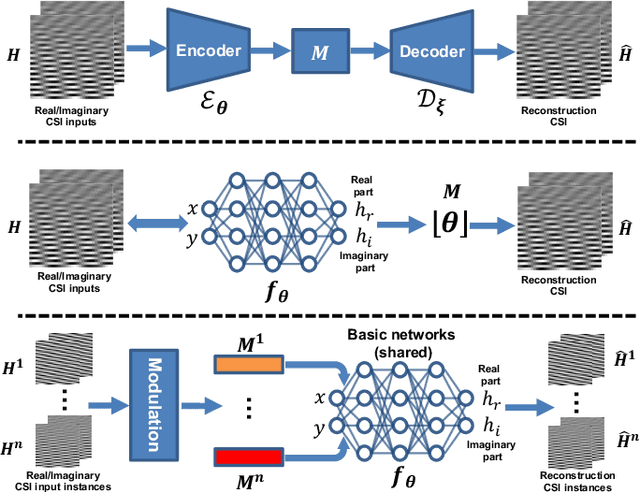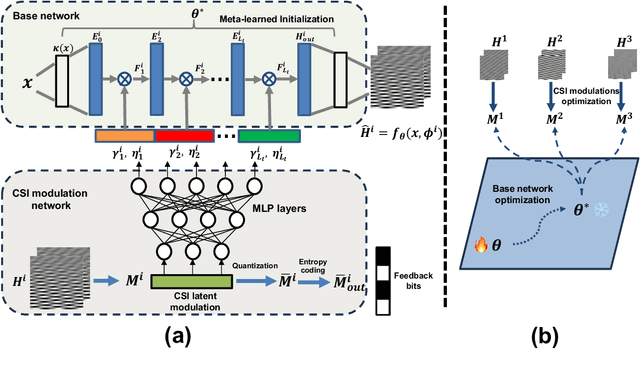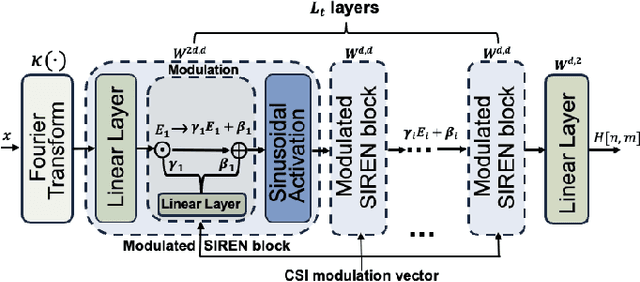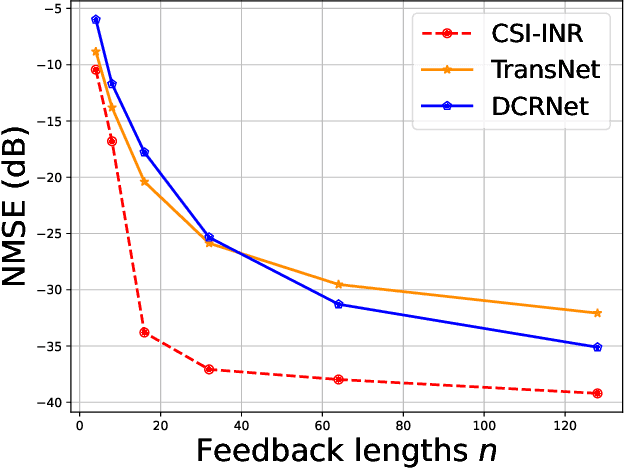Haotian Wu
LotteryCodec: Searching the Implicit Representation in a Random Network for Low-Complexity Image Compression
Jul 01, 2025Abstract:We introduce and validate the lottery codec hypothesis, which states that untrained subnetworks within randomly initialized networks can serve as synthesis networks for overfitted image compression, achieving rate-distortion (RD) performance comparable to trained networks. This hypothesis leads to a new paradigm for image compression by encoding image statistics into the network substructure. Building on this hypothesis, we propose LotteryCodec, which overfits a binary mask to an individual image, leveraging an over-parameterized and randomly initialized network shared by the encoder and the decoder. To address over-parameterization challenges and streamline subnetwork search, we develop a rewind modulation mechanism that improves the RD performance. LotteryCodec outperforms VTM and sets a new state-of-the-art in single-image compression. LotteryCodec also enables adaptive decoding complexity through adjustable mask ratios, offering flexible compression solutions for diverse device constraints and application requirements.
Realizing Fully-Connected Layers Over the Air via Reconfigurable Intelligent Surfaces
May 02, 2025Abstract:By leveraging the waveform superposition property of the multiple access channel, over-the-air computation (AirComp) enables the execution of digital computations through analog means in the wireless domain, leading to faster processing and reduced latency. In this paper, we propose a novel approach to implement a neural network (NN) consisting of digital fully connected (FC) layers using physically reconfigurable hardware. Specifically, we investigate reconfigurable intelligent surfaces (RISs)-assisted multiple-input multiple-output (MIMO) systems to emulate the functionality of a NN for over-the-air inference. In this setup, both the RIS and the transceiver are jointly configured to manipulate the ambient wireless propagation environment, effectively reproducing the adjustable weights of a digital FC layer. We refer to this new computational paradigm as \textit{AirFC}. We formulate an imitation error minimization problem between the effective channel created by RIS and a target FC layer by jointly optimizing over-the-air parameters. To solve this non-convex optimization problem, an extremely low-complexity alternating optimization algorithm is proposed, where semi-closed-form/closed-form solutions for all optimization variables are derived. Simulation results show that the RIS-assisted MIMO-based AirFC can achieve competitive classification accuracy. Furthermore, it is also shown that a multi-RIS configuration significantly outperforms a single-RIS setup, particularly in line-of-sight (LoS)-dominated channels.
Task-Agnostic Semantic Communication with Multimodal Foundation Models
Feb 25, 2025Abstract:Most existing semantic communication (SemCom) systems use deep joint source-channel coding (DeepJSCC) to encode task-specific semantics in a goal-oriented manner. However, their reliance on predefined tasks and datasets significantly limits their flexibility and generalizability in practical deployments. Multi-modal foundation models provide a promising solution by generating universal semantic tokens. Inspired by this, we introduce SemCLIP, a task-agnostic SemCom framework leveraging the contrastive language-image pre-training (CLIP) model. By transmitting CLIP-generated image tokens instead of raw images, SemCLIP enables efficient semantic communications under low bandwidth and challenging channel conditions, facilitating diverse downstream tasks and zero-shot applications. Specifically, we propose a DeepJSCC scheme for efficient CLIP tokens encoding. To mitigate potential degradation caused by compression and channel noise, a multi-modal transmission-aware prompt learning mechanism is designed at the receiver, which adapts prompts based on transmission quality, enhancing system robustness and channel adaptability. Simulation results demonstrate that SemCLIP outperforms the baselines, achieving a $41\%$ improvement in zero-shot accuracy at a low signal-to-noise ratio. Meanwhile, SemCLIP reduces bandwidth usage by more than $50$-fold compared to different image transmission methods, demonstrating the potential of foundation models towards a generalized, task-agnostic SemCom solution.
Multiview Point Cloud Registration Based on Minimum Potential Energy for Free-Form Blade Measurement
Feb 11, 2025Abstract:Point cloud registration is an essential step for free-form blade reconstruction in industrial measurement. Nonetheless, measuring defects of the 3D acquisition system unavoidably result in noisy and incomplete point cloud data, which renders efficient and accurate registration challenging. In this paper, we propose a novel global registration method that is based on the minimum potential energy (MPE) method to address these problems. The basic strategy is that the objective function is defined as the minimum potential energy optimization function of the physical registration system. The function distributes more weight to the majority of inlier points and less weight to the noise and outliers, which essentially reduces the influence of perturbations in the mathematical formulation. We decompose the solution into a globally optimal approximation procedure and a fine registration process with the trimmed iterative closest point algorithm to boost convergence. The approximation procedure consists of two main steps. First, according to the construction of the force traction operator, we can simply compute the position of the potential energy minimum. Second, to find the MPE point, we propose a new theory that employs two flags to observe the status of the registration procedure. We demonstrate the performance of the proposed algorithm on four types of blades. The proposed method outperforms the other global methods in terms of both accuracy and noise resistance.
Semantics-Guided Diffusion for Deep Joint Source-Channel Coding in Wireless Image Transmission
Jan 02, 2025Abstract:Joint source-channel coding (JSCC) offers a promising avenue for enhancing transmission efficiency by jointly incorporating source and channel statistics into the system design. A key advancement in this area is the deep joint source and channel coding (DeepJSCC) technique that designs a direct mapping of input signals to channel symbols parameterized by a neural network, which can be trained for arbitrary channel models and semantic quality metrics. This paper advances the DeepJSCC framework toward a semantics-aligned, high-fidelity transmission approach, called semantics-guided diffusion DeepJSCC (SGD-JSCC). Existing schemes that integrate diffusion models (DMs) with JSCC face challenges in transforming random generation into accurate reconstruction and adapting to varying channel conditions. SGD-JSCC incorporates two key innovations: (1) utilizing some inherent information that contributes to the semantics of an image, such as text description or edge map, to guide the diffusion denoising process; and (2) enabling seamless adaptability to varying channel conditions with the help of a semantics-guided DM for channel denoising. The DM is guided by diverse semantic information and integrates seamlessly with DeepJSCC. In a slow fading channel, SGD-JSCC dynamically adapts to the instantaneous signal-to-noise ratio (SNR) directly estimated from the channel output, thereby eliminating the need for additional pilot transmissions for channel estimation. In a fast fading channel, we introduce a training-free denoising strategy, allowing SGD-JSCC to effectively adjust to fluctuations in channel gains. Numerical results demonstrate that, guided by semantic information and leveraging the powerful DM, our method outperforms existing DeepJSCC schemes, delivering satisfactory reconstruction performance even at extremely poor channel conditions.
DiffCP: Ultra-Low Bit Collaborative Perception via Diffusion Model
Sep 29, 2024



Abstract:Collaborative perception (CP) is emerging as a promising solution to the inherent limitations of stand-alone intelligence. However, current wireless communication systems are unable to support feature-level and raw-level collaborative algorithms due to their enormous bandwidth demands. In this paper, we propose DiffCP, a novel CP paradigm that utilizes a specialized diffusion model to efficiently compress the sensing information of collaborators. By incorporating both geometric and semantic conditions into the generative model, DiffCP enables feature-level collaboration with an ultra-low communication cost, advancing the practical implementation of CP systems. This paradigm can be seamlessly integrated into existing CP algorithms to enhance a wide range of downstream tasks. Through extensive experimentation, we investigate the trade-offs between communication, computation, and performance. Numerical results demonstrate that DiffCP can significantly reduce communication costs by 14.5-fold while maintaining the same performance as the state-of-the-art algorithm.
Uncovering the Secrets of Human-Like Movement: A Fresh Perspective on Motion Planning
Sep 18, 2024



Abstract:This article explores human-like movement from a fresh perspective on motion planning. We analyze the coordinated and compliant movement mechanisms of the human body from the perspective of biomechanics. Based on these mechanisms, we propose an optimal control framework that integrates compliant control dynamics, optimizing robotic arm motion through a response time matrix. This matrix sets the timing parameters for joint movements, turning the system into a time-parameterized optimal control problem. The model focuses on the interaction between active and passive joints under external disturbances, improving adaptability and compliance. This method achieves optimal trajectory generation and balances precision and compliance. Experimental results on both a manipulator and a humanoid robot validate the approach.
An Interactive Multi-modal Query Answering System with Retrieval-Augmented Large Language Models
Jul 05, 2024Abstract:Retrieval-augmented Large Language Models (LLMs) have reshaped traditional query-answering systems, offering unparalleled user experiences. However, existing retrieval techniques often struggle to handle multi-modal query contexts. In this paper, we present an interactive Multi-modal Query Answering (MQA) system, empowered by our newly developed multi-modal retrieval framework and navigation graph index, integrated with cutting-edge LLMs. It comprises five core components: Data Preprocessing, Vector Representation, Index Construction, Query Execution, and Answer Generation, all orchestrated by a dedicated coordinator to ensure smooth data flow from input to answer generation. One notable aspect of MQA is its utilization of contrastive learning to assess the significance of different modalities, facilitating precise measurement of multi-modal information similarity. Furthermore, the system achieves efficient retrieval through our advanced navigation graph index, refined using computational pruning techniques. Another highlight of our system is its pluggable processing framework, allowing seamless integration of embedding models, graph indexes, and LLMs. This flexibility provides users diverse options for gaining insights from their multi-modal knowledge base. A preliminary video introduction of MQA is available at https://youtu.be/xvUuo2ZIqWk.
Pedestrian Attribute Recognition as Label-balanced Multi-label Learning
May 08, 2024



Abstract:Rooting in the scarcity of most attributes, realistic pedestrian attribute datasets exhibit unduly skewed data distribution, from which two types of model failures are delivered: (1) label imbalance: model predictions lean greatly towards the side of majority labels; (2) semantics imbalance: model is easily overfitted on the under-represented attributes due to their insufficient semantic diversity. To render perfect label balancing, we propose a novel framework that successfully decouples label-balanced data re-sampling from the curse of attributes co-occurrence, i.e., we equalize the sampling prior of an attribute while not biasing that of the co-occurred others. To diversify the attributes semantics and mitigate the feature noise, we propose a Bayesian feature augmentation method to introduce true in-distribution novelty. Handling both imbalances jointly, our work achieves best accuracy on various popular benchmarks, and importantly, with minimal computational budget.
MIMO Channel as a Neural Function: Implicit Neural Representations for Extreme CSI Compression in Massive MIMO Systems
Mar 20, 2024



Abstract:Acquiring and utilizing accurate channel state information (CSI) can significantly improve transmission performance, thereby holding a crucial role in realizing the potential advantages of massive multiple-input multiple-output (MIMO) technology. Current prevailing CSI feedback approaches improve precision by employing advanced deep-learning methods to learn representative CSI features for a subsequent compression process. Diverging from previous works, we treat the CSI compression problem in the context of implicit neural representations. Specifically, each CSI matrix is viewed as a neural function that maps the CSI coordinates (antenna number and subchannel) to the corresponding channel gains. Instead of transmitting the parameters of the implicit neural functions directly, we transmit modulations based on the CSI matrix derived through a meta-learning algorithm. Modulations are then applied to a shared base network to generate the elements of the CSI matrix. Modulations corresponding to the CSI matrix are quantized and entropy-coded to further reduce the communication bandwidth, thus achieving extreme CSI compression ratios. Numerical results show that our proposed approach achieves state-of-the-art performance and showcases flexibility in feedback strategies.
 Add to Chrome
Add to Chrome Add to Firefox
Add to Firefox Add to Edge
Add to Edge